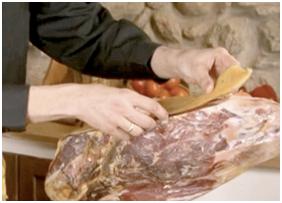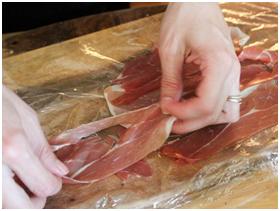All about ham
All about ham
In order to enjoy Iberico ham to its maximum capacity and enjoy all its refined flavor. It is necessary to know everything related to its care, handling, type of cut, but also know how to differentiate the various types of hams, their degrees of quality and other very important aspects of our prestigious gourmet product.
Contents
- 1 Types of Iberico Ham
- 2 How to Consume Iberico Ham
- 3 How to Cut Iberico Ham | Carve Iberico Ham
- 4 How to Preserve and Store Iberico Ham
- 5 Pairing of Iberico Ham
- 6 Quality Laws for Iberico Ham | The New Law 2014
- 7 The Dehesa | The Meadow
- 8 DOP Protected Source of Origin of Iberico Ham
- 9 Nutritional Properties of Acorn-fed Iberico Ham
- 10 Recipes with Spanish Ham
- 11 Differences Between Iberico Ham and Serrano Ham
- 12 Differences Between Shoulder and Iberico ham
- 13 Differences Between Iberico Ham and Iberico Shoulder
- 14 Iberico Ham and its Competitors Around the World
- 15 Nutritional Properties of Iberico Ham
- 16 Protected Denominations of Origin of Iberico Ham
- 17 Production Areas of Spanish Ham and Iberico Ham
- 18 Spanish Ham - Machine cut or Hand cut
- 19 Museums of Iberico Ham Worldwide
- 20 Inside Secrets of Iberico Ham Tasting
- 21 Tourist Trails for Iberico Ham Aficionados
- 22 Acorn-fed Iberico ham and the ideal pairing
- 23 The Production Process of Iberico Sausages
- 24 History of Iberico Sausages
- 25 VAT and Spanish Ham: Frequently Asked Questions
- 26 Spanish Ham in Great Spanish Literature
- 27 Curiosities of Iberico ham
- 28 How to Store Your Serrano Ham
- 29 Regulations and the Quality of Serrano Ham
- 30 Preparation of Serrano Ham
- 31 Denomination of Origin of Serrano Ham
- 32 Nutritional Properties of Serrano Ham
- 33 Recipes With Serrano Ham
- 34 Types of Serrano Ham
- 35 Pairing of Serrano Ham
- 36 How to Consume Serrano Ham
- 37 How to Cut Serrano Ham | Carve Serrano Ham
- 38 All the Secrets of Pata Negra Ham Tasting
- 39 Choosing a Good Ham Holder
- 40 What is the best para negra ham?
- 41 Is the term pata negra correct?
- 42 Pata Negra Ham and Pasture
- 43 The secrets of pairing pata negra ham
- 44 How can you know which ham to buy?
- 45 Why is good ham so expensive?
- 46 How to buy ham from online stores
- 47 Myths and Truths, Benefits and Prejudices of Ham
- 48 Is Iberian ham fattening?
- 49 What to do with the ham bone?
- 50 Why do we usually hang ham?
- 51 Ham and Pregnancy: Can Iberian ham be included in pregnant women's diets?
- 52 The Role of Ham in a Child's Growth and Develeopment
- 53 Tips for Preserving Ham
- 54 What is ham shaping and why is it done?
- 55 New Technologies and Ham - MRI in Ham Tasting - Spectral Images
- 56 The Iberian Pig Begins to Migrate
- 57 Cured Sausages: Origin, Composition and Classification
- 58 Production of Hams and Pork Shoulder Hams
- 59 Iberian Ham Tasting Guide
- 60 Quality: Differential Elements Between Ham and Iberico Cured Meats
- 61 The Map of Ham in Spain
- 62 Properties of the Fat in Iberian Ham
- 63 How to Transport Iberian Ham and Other Foods on International Flights
- 64 Prevalence of Pathogens and Benefits of Organic Acids in Pig Production
How to Preserve and Store Iberico Ham
Iberico ham is a product of high yield, which can occasionally lead to time passing between the first slices removed until only the bone and the meat stuck to the bone are left. For this reason it is very important to know the secrets and tricks to preserve the Iberico ham in the best possible condition.
For optimal preservation there are a few steps to follow during the trimming of a piece. Once the desired slices have been removed, it is necessary to know how to preserve Iberico ham.
It is important that the area where the slices were removed be covered and not exposed to air. You can cover the area by utilizing excess skin and fat to cover the surface of the cut area. In years gone by, the use of olive oil or cayenne pepper were used to ensure preservation.
In the case of Iberico ham these items aren't needed as the ham has been through a long process of drying and curing, and the use of the ham's own fat is more than sufficient to preserve it. In this regard, it is important to cover the rest of the Spanish ham with a dish cloth or a cotton rag.
Cover the area of trimming with skin and fat
In addition, it is recommended to hang the Spanish ham from the hoof in a cool and dry place with a temperature between 10 and 18 degrees Celsius. These conditions are usually found in cellars and pantries. However, some people choose to cover it directly on a jamonero (ham holder).
Which ever way you decide to do this, it is of utmost importance to never cover with plastic wrap as the Spanish ham will sweat and will ruin it's flavor. Every time there is a time gap between trimming slices of ham, you must remove the top superficial part as it will harden and its taste will be bitter.
It is important not to cut more slices than will be consumed, as it is difficult to preserve the organoleptic properties of the cut slices. If for some reason you have more slices than what can be consumed, the best way to keep them is by wrapping the slices in wax paper, and refrigerate during the days needed.
In this case, it is important to let the slices warm to room temperature so the texture, smell and flavor will approximate freshly cut slices.
Store slices in wax paper and keep in the refrigerator
Many people prefer slices that have been vacuum sealed then the ham is stored in a refrigerator. If this is the case there are a few factors to consider before consumption. First of all, the Spanish ham must be eaten while it’s at room temperature (around 21 C), so it's necessary to remove the ham from the fridge and let it sit for a couple hours before it is eaten.
This will ensure maximum flavor and enjoyment. Also, take the ham slices out of the packaging while letting it sit at room temperature. The vacuum sealing is a great way to preserve Iberico ham, however it will cause alteration of the ham's organoleptic properties, which the slices can fully recover while exposed to ambient temperatures.

 English
English Español
Español Deutsch
Deutsch Français
Français Italiano
Italiano Deutsch - Österreich
Deutsch - Österreich Nederlands
Nederlands Português
Português Polski
Polski










